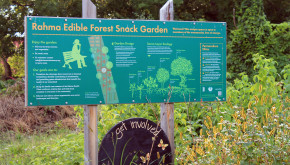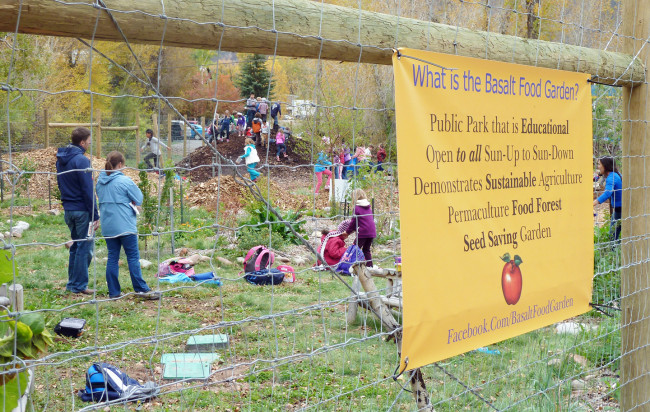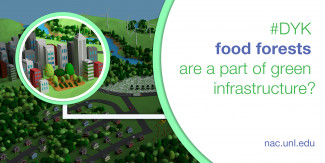
by Kate MacFarland, Forest Service Assistant Agroforester
Across the US, communities are recognizing the importance of urban forests, community gardens, and other green space for residents’ mental and physical health, local and regional environmental benefits, and educational and nutritional opportunities. Food forests are an emerging form of green infrastructure that is becoming more and more common across the country.
Food forests, also called forest gardens, are multistory cropping systems that include a wide range of species. They are designed to echo the niches found in a forest ecosystem, but they include an emphasis on species that are edible. Food forests take a variety of forms that reflect the goals, community values, and environmental conditions in which they are located.
Most food forests are planned, planted, and managed by a community. Rather than being separated into private plots or managed for economic gain, the produce grown in food forests is often shared freely with the public. Food forests are located on land with a range of ownerships, including public property (managed by parks and recreation or public works agencies), land owned by non-profit or community based organizations, vacant lots, or property owned by universities or religious institutions.
Communities start food forests for a variety of reasons, and many communities have a number of goals for their food forests. Catherine Bukowski, a researcher at Virginia Tech, has spent the last several years researching community food forests across the US. She found that one important aspect of community motivation is an interest in social, environmental, and health justice. This focus on justice takes different forms in different communities and, Bukowski says, “Ultimately, the highest yields from community food forests come in the form of education.”
People manage many of the same tree-crop interactions in food forests that are managed in other agroforestry systems. Most agroforestry practices are designed to help agriculture through providing important benefits like increasing crop yield, reducing animal stress, providing new crops, and reducing soil erosion. These same agroforestry practices can be adapted and applied to food forests and other green infrastructure efforts in communities. For example, multifunctional riparian buffer systems can be designed to focus on edible species and installed along waterways in urban areas. In many ways, food forests resemble homegardens or forest farming systems. Like in all agroforestry systems, food forest managers must pay attention to competition for light and water, as well as how the system changes over time.
Food forests are becoming more common in all regions of the US and in communities both large in small. There are now food forests in the majority of US states. Communities with food forests include both Basalt, Colorado (population 3,900) and New York City. Catherine Bukowski has developed a map of these efforts on her website, http://communityfoodforests.com/
A wide variety of agroforestry systems, including food forests, can help communities. The USDA National Agroforestry Center (NAC) offers a variety of resources for integrating agroforestry practices into communities. NAC’s Working Trees for Communities brochure shares ideas on agroforestry practices act as green infrastructure. NAC’s communities page also provides a variety of other general and technical resources on communities and agroforestry available online or in print.



